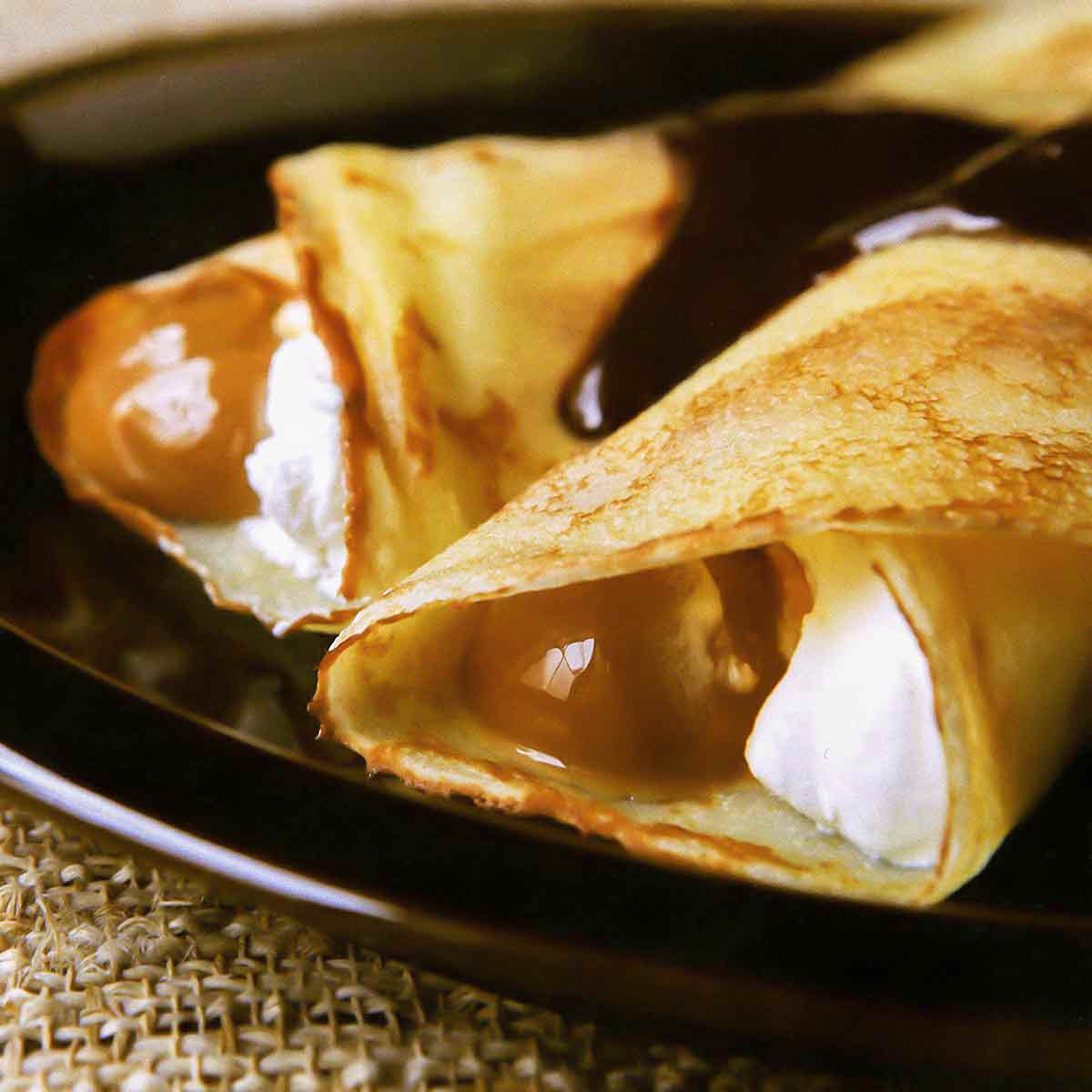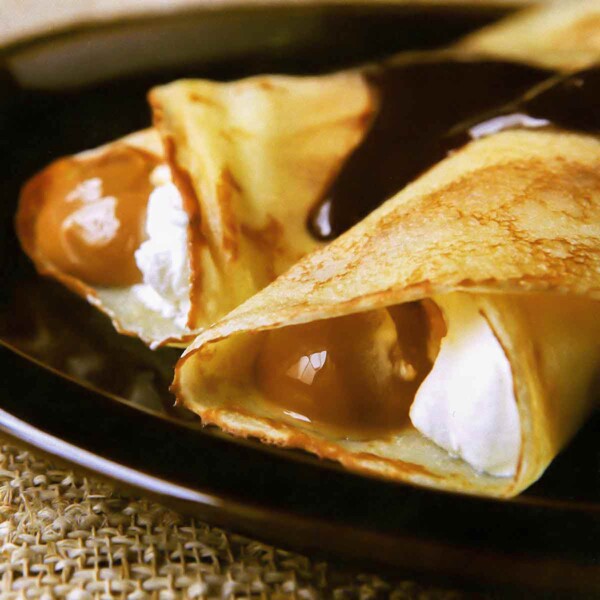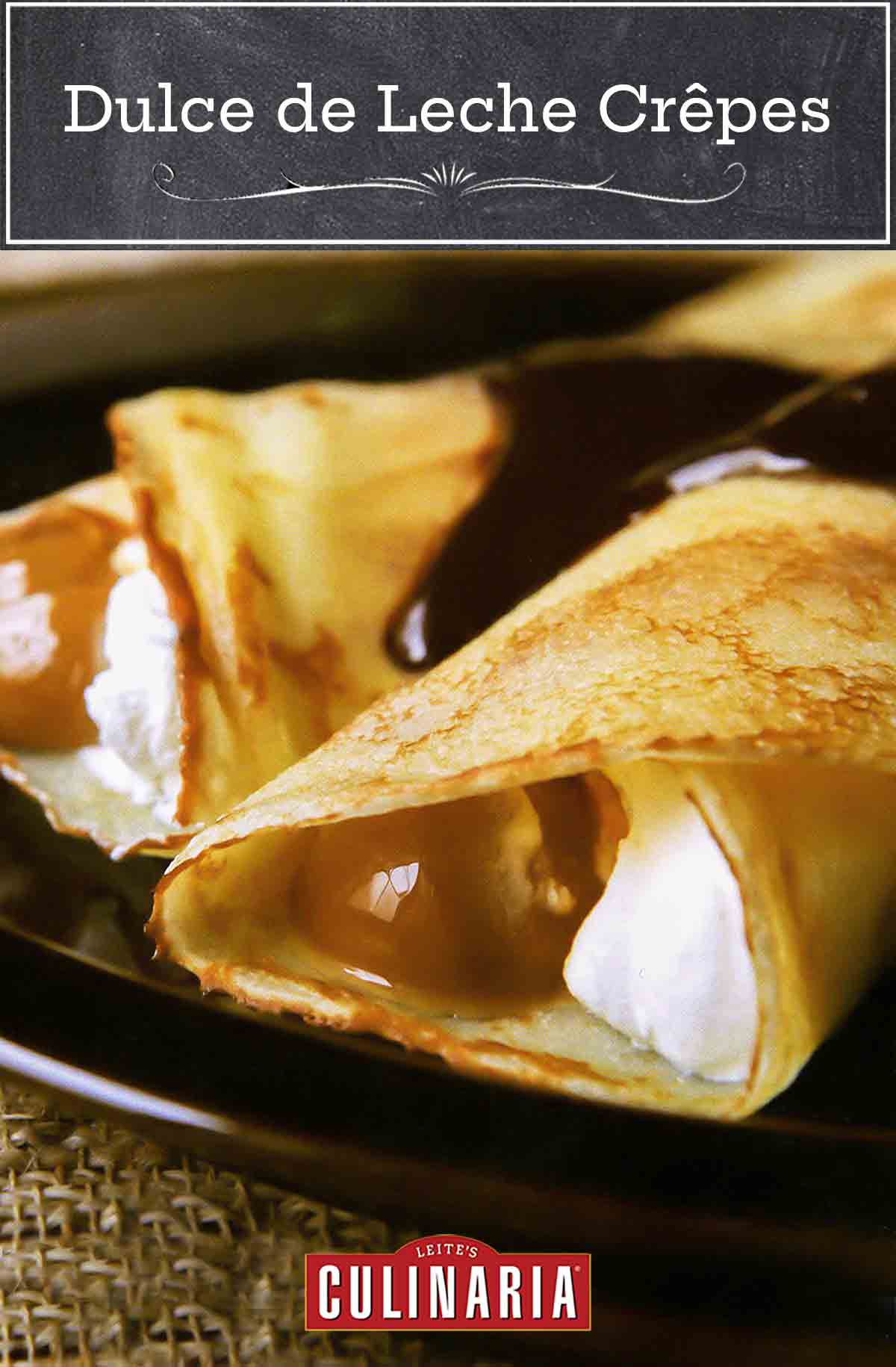
We have a friend named Jeff Salguero who invested in one of the restaurants and whose family is from Uruguay. He goes to South America regularly. And every time he came back, he’d ask why we didn’t have pancakes de dulce de leche on the menu.
Dulce de leche, or milk caramel, is the dessert ingredient of choice all over Latin America, and crêpes filled with dulce de leche and whipped cream are as common in Uruguay as apple pie is in the United States.
Finally, to make Jeff stop asking, we put dulce de leche crepes on the menu. And we named the dessert after him. It took only a few months before customers demanded it at all the other restaurants. That was five years ago. It’s not going anywhere, and Jeff still eats it when he comes for dinner.–Sasa Mahr-Batuz and Andy Pforzheimer
LC Cheater’s Dulce de Leche Note
We swoon to dulce de leche. So much so that if we could, we’d slink into a vat of it and revel until we were giddy. So it’s probably not a bad thing that it takes four hours to magically morph condensed milk into dulce de leche. Though the process isn’t for the impatient. It is as simple as plopping the can in a pot of water and letting it simmer for hours. Should you find yourself with a truly insatiable craving that just can’t wait, look for canned or jarred dulce de leche in most supermarkets. Usually not far from the Latin American products.
Dulce de Leche Crêpes FAQs
Resting the batter is a crucial part of making crêpes. By resting the batter, you allow the flour to bloom, which means to absorb the liquid fully. It also gives the gluten a chance to relax, so no rubbery crêpes.
Your batter should be smooth with no lumps and have the consistency of heavy cream.
For a lighter crêpe batter, substitute club soda for the water in the recipe.
A classic crêpe pan is specially designed to turn out perfect-sized crêpe. Also, its low flared sides make flipping crêpes a cinch. And the thin bottom heats quickly and evenly and when properly seasoned is the ideal nonstick surface. Don’t feel like buying another pan? An 8-to-10-inch nonstick skillet with rounded or flared sides will work well.
Yes, you can. After making the crêpes, just stack them neatly. Slide the crêpe stack into a large resealable plastic bag and toss them in the fridge. The crêpes will keep like this for up to 3 days. Let the stack sit at room temperature until the crêpes are pliable, about an hour, and then peel them apart and proceed with your recipe.

Dulce de Leche Crêpes
Ingredients
For the dulce de leche
- Two (12-ounce) cans condensed milk
For the crepes
- 1 cup all-purpose flour
- 1 cup milk
- 1/2 cup water
- 1 large egg
- 1 tablespoon (1/2 ounce) butter, melted
- 2 tablespoons granulated sugar
For the chocolate sauce
- 1 pound semisweet or bittersweet chocolate, coarsely chopped, or 1 pound semisweet or bittersweet chocolate chips
- 1 1/2 cups heavy cream
- 1/2 cup brewed coffee
For serving
- 2 cups whipped cream, sweetened, if desired
- 2 pints vanilla ice cream
Instructions
Make the dulce de leche
- Remove the labels from the cans of condensed milk and submerge them in a large pot filled with water. Bring to a boil over high heat, reduce to a rapid simmer, and simmer for about 4 hours, adding water as needed. Check often to make sure the cans are always covered with water by at least 1 inch; otherwise they could explode. Remove the cans from the water and let them cool.
Make the crepes batter
- In a large mixing bowl, mix together the flour, milk, water, egg, and melted butter. Whisk by hand for about 2 minutes. Add the sugar and whisk for about 2 minutes longer. Strain through a fine-mesh sieve into a bowl and let the crepe batter rest for about 20 minutes.
Make the chocolate sauce
- Put the chocolate in a microwave-safe bowl and microwave on high for 2 1/2 to 3 minutes, or until softened and shiny. The chocolate will not melt completely. Add the cream and coffee and stir until smooth. Set aside at room temperature.
Make the crepes
- Heat two 9-inch nonstick pans over low heat. If you have seasoned 9-inch crepe pans, use them. Spray lightly with vegetable oil spray and ladle 3 tablespoons crepe batter into the pans. Tip and roll the pans to spread the batter evenly over the bottom of the pans and cook for about 2 minutes. Using a spatula, flip the crepes and cook for 2 minutes longer, or until lightly browned. Lift the crepes from the pans and stack on a plate. These crepes do not stick to one another. Continue cooking the crepes until you have 16. Expect to throw out the first crepe in each pan; this is typical, as anyone who has made crepes or even pancakes knows. The first one never works, and after it has flopped, the pan is seasoned appropriately so that the rest are perfect.
Assemble the crepes and serve
- Open the cans of boiled condensed milk. The milk will be caramel brown and thick—aka dulce de leche.
- Place the crepes on a work surface. Spread a thick stripe—about 2 tablespoons— dulce de leche (the boiled condensed milk) down the center of each crepe. Top the dulce de leche with an equal-size stripe whipped cream. Roll the crepes like a cigar and place 2 crepes on each plate.
- Ladle about 3 tablespoons chocolate sauce over the crepes and serve with the ice cream.
Explore More with AI
Nutrition
Nutrition information is automatically calculated, so should only be used as an approximation.
Recipe Testers’ Reviews
Despite multiple warnings online not to try this method of making dulce de leche at home, I took a deep breath, boiled the water, dropped the can, and committed to sticking around the kitchen and keeping a close eye on the pot while my condensed milk transformed in a sealed can. People have posted so many pictures online of exploded cans with splatters of dulce de leche covering the walls of a kitchen that I made up my mind I would not let that happen.
I kept water very close to the stove so that I could keep replacing the water as it evaporated from the pot. I carefully allowed my can to cool to room temperature and when I opened the can I was delighted by the miracle transformation that had occurred. For the price of a can of condensed milk, I now had a can of dulce de leche.
The two most important points here: 1. Keep the can submerged under water at all times, and 2.) Open the can only after it cools to room temperature.
This dulce de leche crêpes recipe was a risk worth taking! My final product was good, but I can’t help but think that it would have been darker and richer had I been able to keep the water at a constant simmer, which would only have been accomplished using hot water. Next time I’ll use a tea kettle and add hot water, as the room-temperature water seemed to stop the simmering process.











Your crepes look amazing. I’ve been making them for a long time, but now instead of boiling the condensed milk, I use Arequipe Alpina, which has been my favorite since I was a child, and now they are selling it in some places in the US and on Amazon. It takes me less time to make the crepes. For those who don’t have the opportunity to taste LC’s crepes, this is a fast and yummy way to prepare them.